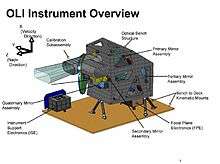Operational Land Imager
The Operational Land Imager (OLI) is a Ball Aerospace & Technologies built instrument that fly on Landsat Data Continuity Mission (LDCM). LDCM is the successor to Landsat 7 and was launched in 2013.[1]

OLI Structure

Satellite image of the Thames Estuary taken by the Operational Land Imager.
OLI uses 4-mirror telescope with fixed mirrors. The OLI is a Push broom scanner.
| Spectral Band | Wavelength | Resolution |
|---|---|---|
| Band 1 – Coastal / Aerosol | 0.433 – 0.453 µm | 30 m |
| Band 2 – Blue | 0.450 – 0.515 µm | 30 m |
| Band 3 – Green | 0.525 – 0.600 µm | 30 m |
| Band 4 – Red | 0.630 – 0.680 µm | 30 m |
| Band 5 – Near Infrared | 0.845 – 0.885 µm | 30 m |
| Band 6 – Short Wavelength Infrared | 1.560 – 1.660 µm | 30 m |
| Band 7 – Short Wavelength Infrared | 2.100 – 2.300 µm | 30 m |
| Band 8 – Panchromatic | 0.500 – 0.680 µm | 15 m |
| Band 9 – Cirrus | 1.360 – 1.390 µm | 30 m |
See also
References
- ↑ Gerace, Aaron D.; Schott, John R.; Nevins, Robert (2013). "Increased potential to monitor water quality in the near-shore environment with Landsat's next-generation satellite" (Open access – full text article available). Journal of Applied Remote Sensing. 7: 073558. Bibcode:2013JARS....7.3558G. doi:10.1117/1.JRS.7.073558.
- ↑ NASA. "Landsat Data Continuity Mission Brochure" (PDF). Retrieved 12 February 2013.
External links
- Ball Aerospace
- OLI at NASA
- The Operational Land Imager: Overview and Performance // Ball Aerospace, 2011
This article is issued from Wikipedia - version of the 11/14/2015. The text is available under the Creative Commons Attribution/Share Alike but additional terms may apply for the media files.